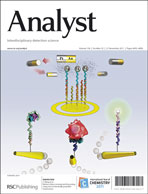Campylobacter jejuni is found in the intestines of poultry, cattle, swine, wild birds and pet animals and is the major cause of foodborne gastroenteritis in developed countries. We report the use of the receptor binding protein (RBP) of Campylobacter bacteriophage NCTC 12673 for the specific capture of Campylobacter jejuni bacteria using RBP-derivatized capturing surfaces. The Gp48 RBP was expressed as a glutathione S-transferase-Gp48 (GST-Gp48) fusion protein and immobilized onto surface plasmon resonance (SPR) surfaces using glutathione self-assembled monolayers (GSH SAM). Bovine serum albumin (BSA) was used to block any non-specific binding. Glutathione SAM leads to an oriented attachment of the protein, resulting in a two- to three-fold improvement of bacterial capture when compared to dithiobis(succinimidyl propionate) (DTSP) SAM-based unoriented attachment. The specificity of recognition was confirmed using Salmonella enterica subsp. enterica serovar Typhimurium as a negative control, which indeed showed negligible binding. The detection limit of the RBP-derivatized SPR surfaces was found to be 102 cfu/ml. Finally, GST-Gp48 was also immobilized onto magnetic beads that were successfully used to capture and pre-concentrate the host pathogen from suspension.

You have access to this article
 Please wait while we load your content...
Something went wrong. Try again?
Please wait while we load your content...
Something went wrong. Try again?


 Please wait while we load your content...
Please wait while we load your content...